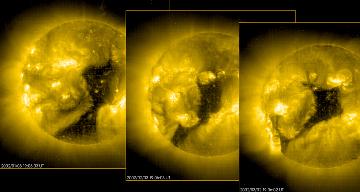PICK OF THE WEEK
Pick of The Week
Persistent Coronal Hole (March 5, 2002)

|
Coronal holes appear as dark areas of the corona when viewed in
ultraviolet light. This extended hole has lasted through three solar
rotations (almost 3 months- longer than most) and is one of the
largest seen by SOHO. Although they are usually located at the poles
of the Sun, coronal holes can occur other places as well. The
magnetic field lines in a coronal hole extend out into the solar wind
rather than coming back down to the Sun's surface as they do in other
parts of the Sun. Thus, they are often the source of strong solar
wind gusts that carry solar particles into space and can impact the
Earth. And holes that cross the solar equator ("transequatorial
holes") are most likely to have geomagnetic effects. The effect of
this most recent coronal hole was detected by the ACE spacecraft on 5
March 2002 as a blast of high speed solar wind that may cause aurora
to appear at higher latitudes.
Previous Picks of the Week SOHO began its Weekly Pick some time after sending a weekly image or video clip to the American Museum of Natural History (Rose Center) in New York City. There, the SOHO Weekly Pick is displayed with some annotations on a large plasma display. If your institution would also like to receive the same Weekly Pick from us for display (usually in Photoshop or QuickTime format), please send your inquiry to steele.hill@gsfc.nasa.gov. |


